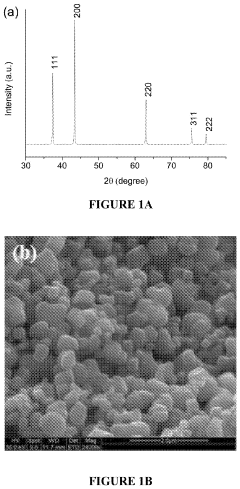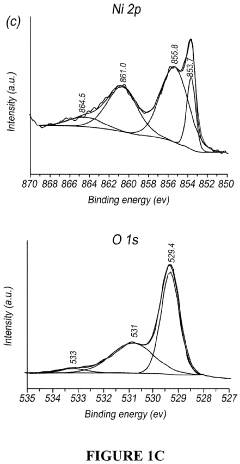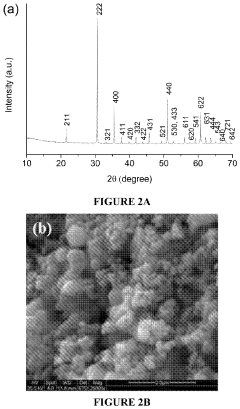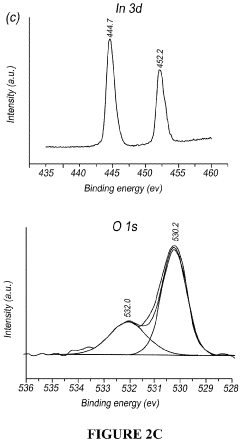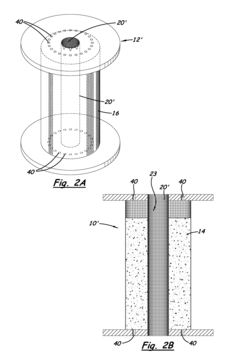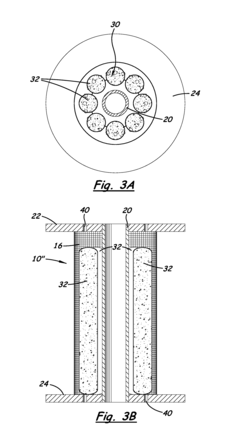Developing Sensors to Detect Geometric Isomers in Environmental Samples
AUG 1, 20259 MIN READ
Generate Your Research Report Instantly with AI Agent
Patsnap Eureka helps you evaluate technical feasibility & market potential.
Isomer Detection Goals
The development of sensors to detect geometric isomers in environmental samples is a critical technological goal with far-reaching implications for environmental monitoring, quality control, and public health. This objective aims to create highly sensitive and selective sensors capable of distinguishing between structurally similar compounds that differ only in their spatial arrangement of atoms.
One primary goal is to achieve high specificity in isomer detection. Environmental samples often contain complex mixtures of compounds, making it challenging to isolate and identify specific isomers. The sensors must be designed to differentiate between geometric isomers with minimal interference from other substances present in the sample. This requires the development of advanced recognition elements, such as molecularly imprinted polymers or engineered proteins, that can bind selectively to target isomers.
Another crucial objective is to enhance the sensitivity of these sensors. Many isomers exist in trace amounts in environmental samples, necessitating detection limits in the parts per billion or even parts per trillion range. Achieving such low detection limits demands innovative signal amplification strategies and the integration of cutting-edge nanomaterials or quantum sensing technologies.
Rapid and real-time detection capabilities are also essential goals in isomer sensor development. Environmental monitoring often requires quick response times to identify and address potential hazards promptly. The aim is to create sensors that can provide accurate results within minutes or even seconds, enabling on-site analysis and immediate decision-making.
Robustness and reliability under varying environmental conditions represent another critical objective. Sensors must maintain their performance across a wide range of temperatures, humidity levels, and potentially harsh chemical environments. This goal necessitates the development of stable sensing materials and protective packaging solutions to ensure long-term functionality in field applications.
Miniaturization and portability are additional key aims in sensor development. The ability to deploy these sensors in diverse environmental settings, from remote wilderness areas to urban centers, requires compact and easily transportable designs. This goal drives research into microfluidic systems, lab-on-a-chip technologies, and integration with mobile devices for data collection and analysis.
Lastly, the development of multi-isomer detection capabilities is a forward-looking objective. Creating sensors that can simultaneously detect and differentiate multiple geometric isomers in a single sample would greatly enhance the efficiency and breadth of environmental monitoring efforts. This goal pushes the boundaries of sensor array technologies and pattern recognition algorithms to enable comprehensive isomer profiling in complex environmental matrices.
One primary goal is to achieve high specificity in isomer detection. Environmental samples often contain complex mixtures of compounds, making it challenging to isolate and identify specific isomers. The sensors must be designed to differentiate between geometric isomers with minimal interference from other substances present in the sample. This requires the development of advanced recognition elements, such as molecularly imprinted polymers or engineered proteins, that can bind selectively to target isomers.
Another crucial objective is to enhance the sensitivity of these sensors. Many isomers exist in trace amounts in environmental samples, necessitating detection limits in the parts per billion or even parts per trillion range. Achieving such low detection limits demands innovative signal amplification strategies and the integration of cutting-edge nanomaterials or quantum sensing technologies.
Rapid and real-time detection capabilities are also essential goals in isomer sensor development. Environmental monitoring often requires quick response times to identify and address potential hazards promptly. The aim is to create sensors that can provide accurate results within minutes or even seconds, enabling on-site analysis and immediate decision-making.
Robustness and reliability under varying environmental conditions represent another critical objective. Sensors must maintain their performance across a wide range of temperatures, humidity levels, and potentially harsh chemical environments. This goal necessitates the development of stable sensing materials and protective packaging solutions to ensure long-term functionality in field applications.
Miniaturization and portability are additional key aims in sensor development. The ability to deploy these sensors in diverse environmental settings, from remote wilderness areas to urban centers, requires compact and easily transportable designs. This goal drives research into microfluidic systems, lab-on-a-chip technologies, and integration with mobile devices for data collection and analysis.
Lastly, the development of multi-isomer detection capabilities is a forward-looking objective. Creating sensors that can simultaneously detect and differentiate multiple geometric isomers in a single sample would greatly enhance the efficiency and breadth of environmental monitoring efforts. This goal pushes the boundaries of sensor array technologies and pattern recognition algorithms to enable comprehensive isomer profiling in complex environmental matrices.
Environmental Monitoring Market Analysis
The environmental monitoring market has experienced significant growth in recent years, driven by increasing awareness of environmental issues, stringent regulations, and technological advancements. The global market for environmental monitoring solutions is expected to continue its upward trajectory, with a particular focus on innovative sensor technologies for detecting and analyzing various pollutants and contaminants.
In the context of developing sensors to detect geometric isomers in environmental samples, there is a growing demand for more sophisticated and accurate monitoring tools. Geometric isomers, which have the same molecular formula but different spatial arrangements of atoms, can have varying environmental impacts and health effects. The ability to detect and differentiate these isomers is crucial for comprehensive environmental assessment and regulatory compliance.
The market for sensors capable of detecting geometric isomers is primarily driven by industries such as petrochemicals, pharmaceuticals, and agriculture, where isomeric compounds are commonly used or produced. Environmental agencies and research institutions also contribute significantly to the demand for these specialized sensors. As awareness of the potential environmental and health impacts of geometric isomers grows, the market for detection technologies is expected to expand further.
Geographically, North America and Europe currently lead the market for advanced environmental monitoring technologies, including sensors for geometric isomer detection. This is largely due to stringent environmental regulations and well-established research and development infrastructure in these regions. However, rapid industrialization and increasing environmental concerns in Asia-Pacific countries, particularly China and India, are creating new growth opportunities for the market.
The market is characterized by a mix of established players and innovative start-ups. Large analytical instrument manufacturers are investing in developing multi-functional sensors that can detect a wide range of compounds, including geometric isomers. Meanwhile, specialized companies are focusing on creating highly sensitive and selective sensors specifically for isomer detection in environmental samples.
Key market trends include the integration of artificial intelligence and machine learning algorithms to enhance sensor performance and data interpretation. There is also a growing emphasis on developing portable and field-deployable sensors, enabling real-time monitoring and rapid decision-making in environmental management scenarios.
The potential applications of sensors for geometric isomer detection extend beyond traditional environmental monitoring. Emerging areas of interest include food safety, where isomeric compounds can affect product quality and safety, and personalized healthcare, where monitoring exposure to specific isomers could provide valuable health insights.
In the context of developing sensors to detect geometric isomers in environmental samples, there is a growing demand for more sophisticated and accurate monitoring tools. Geometric isomers, which have the same molecular formula but different spatial arrangements of atoms, can have varying environmental impacts and health effects. The ability to detect and differentiate these isomers is crucial for comprehensive environmental assessment and regulatory compliance.
The market for sensors capable of detecting geometric isomers is primarily driven by industries such as petrochemicals, pharmaceuticals, and agriculture, where isomeric compounds are commonly used or produced. Environmental agencies and research institutions also contribute significantly to the demand for these specialized sensors. As awareness of the potential environmental and health impacts of geometric isomers grows, the market for detection technologies is expected to expand further.
Geographically, North America and Europe currently lead the market for advanced environmental monitoring technologies, including sensors for geometric isomer detection. This is largely due to stringent environmental regulations and well-established research and development infrastructure in these regions. However, rapid industrialization and increasing environmental concerns in Asia-Pacific countries, particularly China and India, are creating new growth opportunities for the market.
The market is characterized by a mix of established players and innovative start-ups. Large analytical instrument manufacturers are investing in developing multi-functional sensors that can detect a wide range of compounds, including geometric isomers. Meanwhile, specialized companies are focusing on creating highly sensitive and selective sensors specifically for isomer detection in environmental samples.
Key market trends include the integration of artificial intelligence and machine learning algorithms to enhance sensor performance and data interpretation. There is also a growing emphasis on developing portable and field-deployable sensors, enabling real-time monitoring and rapid decision-making in environmental management scenarios.
The potential applications of sensors for geometric isomer detection extend beyond traditional environmental monitoring. Emerging areas of interest include food safety, where isomeric compounds can affect product quality and safety, and personalized healthcare, where monitoring exposure to specific isomers could provide valuable health insights.
Geometric Isomer Sensing Challenges
The development of sensors to detect geometric isomers in environmental samples faces several significant challenges. One of the primary obstacles is the structural similarity between geometric isomers, which makes it difficult to differentiate them using conventional sensing techniques. These isomers have identical molecular formulas and bonding arrangements but differ only in the spatial orientation of their atoms or groups, requiring highly sensitive and specific detection methods.
Another challenge lies in the low concentrations of geometric isomers typically found in environmental samples. Many isomers are present at trace levels, necessitating sensors with extremely low detection limits and high sensitivity. This requirement often pushes the boundaries of current sensor technologies and demands innovative approaches to signal amplification and noise reduction.
The complex matrix of environmental samples presents additional hurdles for isomer detection. Natural waters, soils, and air samples contain a myriad of compounds that can interfere with sensor performance, leading to false positives or negatives. Developing sensors that can selectively identify geometric isomers amidst this background of potentially interfering substances is a formidable task, requiring advanced molecular recognition strategies and sophisticated signal processing algorithms.
Stability and durability of sensors in diverse environmental conditions pose another significant challenge. Sensors must maintain their performance across a range of temperatures, pH levels, and in the presence of various chemical species. This is particularly crucial for long-term environmental monitoring applications, where sensors may need to operate continuously in harsh conditions for extended periods.
The need for real-time or near-real-time detection adds another layer of complexity to sensor development. Many environmental applications require rapid analysis to enable timely decision-making and response actions. This necessitates the integration of fast-acting sensing elements with efficient data processing and reporting systems, often in compact and portable formats suitable for field use.
Calibration and standardization of isomer sensors present additional challenges, particularly when dealing with a wide range of potential isomers in varying environmental matrices. Developing reliable calibration methods and reference standards for diverse isomeric compounds is essential for ensuring accurate and comparable results across different sensing platforms and environmental conditions.
Lastly, the cost-effectiveness and scalability of sensor production remain significant hurdles. While highly sophisticated laboratory techniques can often distinguish between geometric isomers, translating these capabilities into affordable, mass-producible sensors for widespread environmental monitoring is a considerable challenge. Balancing performance with cost considerations is crucial for the practical implementation of isomer sensing technologies in real-world environmental applications.
Another challenge lies in the low concentrations of geometric isomers typically found in environmental samples. Many isomers are present at trace levels, necessitating sensors with extremely low detection limits and high sensitivity. This requirement often pushes the boundaries of current sensor technologies and demands innovative approaches to signal amplification and noise reduction.
The complex matrix of environmental samples presents additional hurdles for isomer detection. Natural waters, soils, and air samples contain a myriad of compounds that can interfere with sensor performance, leading to false positives or negatives. Developing sensors that can selectively identify geometric isomers amidst this background of potentially interfering substances is a formidable task, requiring advanced molecular recognition strategies and sophisticated signal processing algorithms.
Stability and durability of sensors in diverse environmental conditions pose another significant challenge. Sensors must maintain their performance across a range of temperatures, pH levels, and in the presence of various chemical species. This is particularly crucial for long-term environmental monitoring applications, where sensors may need to operate continuously in harsh conditions for extended periods.
The need for real-time or near-real-time detection adds another layer of complexity to sensor development. Many environmental applications require rapid analysis to enable timely decision-making and response actions. This necessitates the integration of fast-acting sensing elements with efficient data processing and reporting systems, often in compact and portable formats suitable for field use.
Calibration and standardization of isomer sensors present additional challenges, particularly when dealing with a wide range of potential isomers in varying environmental matrices. Developing reliable calibration methods and reference standards for diverse isomeric compounds is essential for ensuring accurate and comparable results across different sensing platforms and environmental conditions.
Lastly, the cost-effectiveness and scalability of sensor production remain significant hurdles. While highly sophisticated laboratory techniques can often distinguish between geometric isomers, translating these capabilities into affordable, mass-producible sensors for widespread environmental monitoring is a considerable challenge. Balancing performance with cost considerations is crucial for the practical implementation of isomer sensing technologies in real-world environmental applications.
Current Isomer Detection Methods
01 Image sensor technology
Advanced image sensor technologies are employed for various detection applications. These sensors can capture high-quality images and video, enabling accurate object recognition, motion detection, and environmental monitoring. The technology includes improvements in sensor resolution, sensitivity, and processing capabilities for enhanced performance in different lighting conditions and scenarios.- Motion and gesture detection sensors: These sensors are designed to detect and interpret human movements and gestures. They can be used in various applications such as gaming, security systems, and human-computer interaction. The technology often involves the use of accelerometers, gyroscopes, or optical sensors to capture and analyze motion data.
- Environmental and atmospheric sensors: These sensors are used to detect and measure various environmental factors such as temperature, humidity, air quality, and atmospheric pressure. They play a crucial role in weather monitoring, climate control systems, and environmental protection applications. The sensors often utilize advanced materials and technologies to ensure accurate and reliable measurements.
- Biometric and health monitoring sensors: These sensors are designed to detect and monitor various physiological parameters of the human body. They can measure heart rate, blood pressure, oxygen saturation, and other vital signs. The technology is widely used in healthcare, fitness tracking, and personal wellness applications. These sensors often incorporate advanced signal processing and data analysis techniques.
- Automotive and vehicle sensors: These sensors are used in vehicles for various purposes such as collision avoidance, parking assistance, and engine management. They can detect obstacles, measure speed and acceleration, and monitor vehicle performance. The technology often involves the use of radar, lidar, or ultrasonic sensors, combined with sophisticated data processing algorithms.
- Image and optical sensors: These sensors are designed to capture and process visual information. They are used in a wide range of applications including digital cameras, machine vision systems, and surveillance equipment. The technology often involves advanced image processing techniques, high-resolution sensor arrays, and sophisticated optics to ensure high-quality image capture and analysis.
02 Radar and motion detection systems
Radar and motion detection systems are utilized for sensing movement, presence, and proximity of objects or individuals. These systems employ various techniques such as Doppler effect, time-of-flight measurements, and signal processing algorithms to detect and track targets. Applications include automotive safety, security systems, and gesture recognition interfaces.Expand Specific Solutions03 Biometric and health monitoring sensors
Sensors designed for biometric and health monitoring applications are developed to measure various physiological parameters. These include heart rate, blood pressure, body temperature, and other vital signs. The sensors can be wearable, implantable, or integrated into devices for continuous health tracking and early detection of medical conditions.Expand Specific Solutions04 Environmental and chemical sensing
Sensors for detecting environmental factors and chemical compounds are developed for various applications. These sensors can measure air quality, water contamination, gas leaks, and other environmental parameters. They utilize different sensing mechanisms such as electrochemical, optical, and semiconductor-based technologies to provide accurate and real-time data for monitoring and analysis.Expand Specific Solutions05 Sensor fusion and intelligent detection systems
Advanced detection systems incorporate multiple sensor types and data fusion techniques to improve accuracy and reliability. These systems combine inputs from various sensors such as cameras, radar, lidar, and other sensing modalities. Machine learning and artificial intelligence algorithms are employed to process and interpret the multi-sensor data, enabling more robust and context-aware detection capabilities.Expand Specific Solutions
Key Players in Isomer Detection
The development of sensors for detecting geometric isomers in environmental samples is in an emerging phase, with growing market potential driven by increasing environmental concerns. The technology is still evolving, with varying levels of maturity across different applications. Key players like Robert Bosch GmbH and Sony Group Corp. are leveraging their expertise in sensor technologies to advance this field. Academic institutions such as Jilin University, California Institute of Technology, and Massachusetts Institute of Technology are contributing significant research efforts. Collaborations between industry and academia, exemplified by partnerships involving Unibest International LLC and the Commissariat à l'énergie atomique et aux énergies Alternatives, are accelerating progress in this domain. The market is expected to expand as environmental regulations become more stringent, driving demand for precise isomer detection capabilities.
Robert Bosch GmbH
Technical Solution: Bosch has developed a multi-sensor array system for detecting geometric isomers in environmental samples. Their approach combines electrochemical sensors, miniaturized gas chromatography columns, and advanced signal processing algorithms. The system utilizes an array of modified electrodes with specific molecular recognition elements tailored to different isomers[2]. This allows for simultaneous detection of multiple isomers in a single sample. Bosch's technology also incorporates a pre-concentration step using selective adsorbents to enhance sensitivity for trace-level detection. The integrated gas chromatography component provides additional separation capability for complex mixtures[4]. Real-time data analysis is performed using machine learning algorithms to interpret the multi-dimensional sensor responses and identify specific isomers.
Strengths: Versatile multi-sensor approach, suitable for field deployment, real-time analysis capabilities. Weaknesses: Potential for sensor drift over time, may require periodic recalibration.
California Institute of Technology
Technical Solution: Caltech has pioneered the development of nanophotonic sensors for detecting geometric isomers in environmental samples. Their approach utilizes silicon photonic crystal cavities functionalized with molecularly imprinted polymers (MIPs) specific to different isomers[5]. The photonic crystal structure provides high sensitivity through enhanced light-matter interactions, while the MIPs offer selective binding sites for target isomers. Caltech researchers have also integrated these sensors with microfluidic channels for automated sample handling and continuous monitoring applications. The system employs wavelength shift detection to quantify isomer concentrations, with a reported detection limit in the parts-per-billion range[6]. Additionally, they have developed a multiplexed sensor array capable of simultaneously detecting multiple geometric isomers by using different MIP formulations on a single chip.
Strengths: Extremely high sensitivity, potential for miniaturization and integration into portable devices. Weaknesses: Fabrication complexity, potential for non-specific binding in complex environmental matrices.
Innovative Sensor Designs
Sensors employing a p-n semiconducting oxide heterostructure and methods of using thereof
PatentInactiveUS20210148877A1
Innovation
- The development of p-n metal oxide semiconductor (MOS) heterostructure-based sensors and systems that utilize a p-type MOS material like NiO and an n-type MOS material like In2O3, arranged adjacent to each other, to detect ammonia at concentrations as low as 50 ppb, while minimizing interference from gases like carbon monoxide, nitric oxide, and hydrocarbons.
Environmental sampler and methods of using same
PatentActiveUS20120222500A1
Innovation
- A sampler system comprising ion-exchange resin or other absorbents placed in strategic locations, equipped with real-time sensors, to collect and analyze contaminants, providing baseline concentrations, source location identification, and contaminant migration routes, using a fluid-permeable enclosure that allows for continuous monitoring with minimal disruption.
Regulatory Framework
The regulatory framework surrounding the development and use of sensors for detecting geometric isomers in environmental samples is complex and multifaceted. It encompasses various levels of governance, from international agreements to local regulations, all aimed at ensuring environmental protection, public health, and scientific integrity.
At the international level, organizations such as the United Nations Environment Programme (UNEP) and the World Health Organization (WHO) provide guidelines and standards for environmental monitoring and chemical analysis. These frameworks often serve as a basis for national and regional regulations, emphasizing the importance of accurate and reliable detection methods for environmental contaminants, including geometric isomers.
In the United States, the Environmental Protection Agency (EPA) plays a crucial role in establishing and enforcing regulations related to environmental sensing technologies. The EPA's Method 8000D for chromatographic procedures and Method 8270E for semivolatile organic compounds by gas chromatography/mass spectrometry (GC/MS) are particularly relevant for the detection of geometric isomers. These methods set strict quality control and assurance protocols that any new sensor technology must meet or exceed to be considered for regulatory compliance.
The European Union's REACH (Registration, Evaluation, Authorization and Restriction of Chemicals) regulation and the Water Framework Directive also impact the development of sensors for geometric isomer detection. These regulations mandate the monitoring of specific chemicals in environmental matrices and set maximum allowable concentrations, driving the need for increasingly sensitive and selective detection methods.
In addition to environmental regulations, sensor development must also comply with standards set by organizations such as the International Organization for Standardization (ISO) and ASTM International. These standards ensure the reliability, reproducibility, and comparability of analytical results across different laboratories and jurisdictions.
Regulatory bodies also focus on the validation and certification of new sensing technologies. For instance, the EPA's Environmental Technology Verification (ETV) Program, although now concluded, has set precedents for how new environmental technologies, including sensors, are evaluated and approved for use in regulatory contexts. Similar programs exist in other countries, such as the Environmental Technology Verification program in Canada.
As the field of sensor technology advances, regulatory frameworks are evolving to keep pace. There is an increasing emphasis on real-time monitoring capabilities, miniaturization, and field-deployable sensors. This shift is reflected in emerging regulations that encourage the use of innovative technologies for environmental monitoring, provided they meet or exceed the performance of traditional laboratory-based methods.
At the international level, organizations such as the United Nations Environment Programme (UNEP) and the World Health Organization (WHO) provide guidelines and standards for environmental monitoring and chemical analysis. These frameworks often serve as a basis for national and regional regulations, emphasizing the importance of accurate and reliable detection methods for environmental contaminants, including geometric isomers.
In the United States, the Environmental Protection Agency (EPA) plays a crucial role in establishing and enforcing regulations related to environmental sensing technologies. The EPA's Method 8000D for chromatographic procedures and Method 8270E for semivolatile organic compounds by gas chromatography/mass spectrometry (GC/MS) are particularly relevant for the detection of geometric isomers. These methods set strict quality control and assurance protocols that any new sensor technology must meet or exceed to be considered for regulatory compliance.
The European Union's REACH (Registration, Evaluation, Authorization and Restriction of Chemicals) regulation and the Water Framework Directive also impact the development of sensors for geometric isomer detection. These regulations mandate the monitoring of specific chemicals in environmental matrices and set maximum allowable concentrations, driving the need for increasingly sensitive and selective detection methods.
In addition to environmental regulations, sensor development must also comply with standards set by organizations such as the International Organization for Standardization (ISO) and ASTM International. These standards ensure the reliability, reproducibility, and comparability of analytical results across different laboratories and jurisdictions.
Regulatory bodies also focus on the validation and certification of new sensing technologies. For instance, the EPA's Environmental Technology Verification (ETV) Program, although now concluded, has set precedents for how new environmental technologies, including sensors, are evaluated and approved for use in regulatory contexts. Similar programs exist in other countries, such as the Environmental Technology Verification program in Canada.
As the field of sensor technology advances, regulatory frameworks are evolving to keep pace. There is an increasing emphasis on real-time monitoring capabilities, miniaturization, and field-deployable sensors. This shift is reflected in emerging regulations that encourage the use of innovative technologies for environmental monitoring, provided they meet or exceed the performance of traditional laboratory-based methods.
Environmental Impact Assessment
The development of sensors to detect geometric isomers in environmental samples has significant implications for environmental impact assessment. These sensors provide a powerful tool for monitoring and analyzing the presence of various chemical compounds in ecosystems, enabling more comprehensive and accurate environmental evaluations.
Geometric isomers, which have the same molecular formula but different spatial arrangements of atoms, can exhibit distinct environmental behaviors and impacts. The ability to detect and differentiate these isomers in environmental samples is crucial for understanding their fate, transport, and potential effects on ecosystems. Sensors designed for this purpose contribute to more nuanced and detailed environmental impact assessments.
One of the primary benefits of these sensors is their potential to enhance the detection and quantification of pollutants in various environmental matrices, including water, soil, and air. By accurately identifying geometric isomers, environmental scientists and regulators can better assess the risks associated with specific chemical compounds and their isomeric forms. This improved understanding allows for more targeted and effective mitigation strategies to protect ecosystems and human health.
Furthermore, the implementation of these sensors in environmental monitoring programs can lead to the discovery of previously undetected isomers or variations in isomer ratios. Such findings may reveal new insights into the environmental fate and behavior of chemicals, potentially uncovering unexpected ecological impacts or exposure pathways that were not previously considered in environmental assessments.
The use of advanced sensors for geometric isomer detection also has implications for regulatory compliance and environmental policy. As these technologies become more widely adopted, they may influence the development of more stringent environmental standards and regulations. Policymakers and regulatory bodies may use the data generated by these sensors to refine environmental quality criteria and establish more precise thresholds for chemical concentrations in various environmental compartments.
In the context of long-term environmental monitoring, these sensors offer the potential for continuous and real-time data collection. This capability is particularly valuable for assessing the temporal and spatial variations in isomer concentrations, which can be influenced by factors such as seasonal changes, weather patterns, and human activities. The resulting high-resolution data sets can significantly enhance the accuracy and reliability of environmental impact models and predictions.
Moreover, the integration of geometric isomer detection sensors into environmental impact assessment protocols may lead to more holistic and interdisciplinary approaches. By providing detailed chemical information, these sensors can facilitate better collaboration between chemists, ecologists, toxicologists, and other environmental scientists, resulting in more comprehensive and integrated assessments of ecosystem health and environmental quality.
Geometric isomers, which have the same molecular formula but different spatial arrangements of atoms, can exhibit distinct environmental behaviors and impacts. The ability to detect and differentiate these isomers in environmental samples is crucial for understanding their fate, transport, and potential effects on ecosystems. Sensors designed for this purpose contribute to more nuanced and detailed environmental impact assessments.
One of the primary benefits of these sensors is their potential to enhance the detection and quantification of pollutants in various environmental matrices, including water, soil, and air. By accurately identifying geometric isomers, environmental scientists and regulators can better assess the risks associated with specific chemical compounds and their isomeric forms. This improved understanding allows for more targeted and effective mitigation strategies to protect ecosystems and human health.
Furthermore, the implementation of these sensors in environmental monitoring programs can lead to the discovery of previously undetected isomers or variations in isomer ratios. Such findings may reveal new insights into the environmental fate and behavior of chemicals, potentially uncovering unexpected ecological impacts or exposure pathways that were not previously considered in environmental assessments.
The use of advanced sensors for geometric isomer detection also has implications for regulatory compliance and environmental policy. As these technologies become more widely adopted, they may influence the development of more stringent environmental standards and regulations. Policymakers and regulatory bodies may use the data generated by these sensors to refine environmental quality criteria and establish more precise thresholds for chemical concentrations in various environmental compartments.
In the context of long-term environmental monitoring, these sensors offer the potential for continuous and real-time data collection. This capability is particularly valuable for assessing the temporal and spatial variations in isomer concentrations, which can be influenced by factors such as seasonal changes, weather patterns, and human activities. The resulting high-resolution data sets can significantly enhance the accuracy and reliability of environmental impact models and predictions.
Moreover, the integration of geometric isomer detection sensors into environmental impact assessment protocols may lead to more holistic and interdisciplinary approaches. By providing detailed chemical information, these sensors can facilitate better collaboration between chemists, ecologists, toxicologists, and other environmental scientists, resulting in more comprehensive and integrated assessments of ecosystem health and environmental quality.
Unlock deeper insights with Patsnap Eureka Quick Research — get a full tech report to explore trends and direct your research. Try now!
Generate Your Research Report Instantly with AI Agent
Supercharge your innovation with Patsnap Eureka AI Agent Platform!
